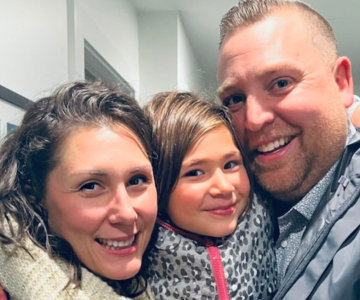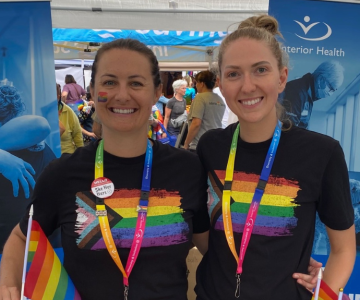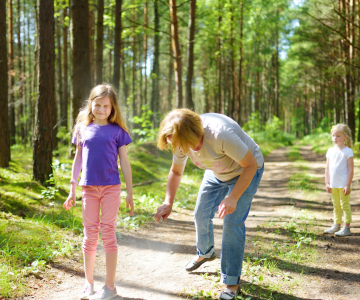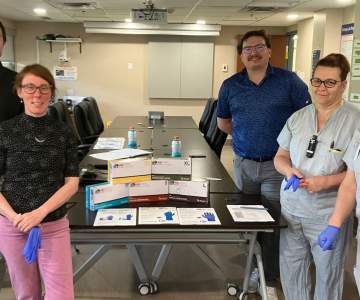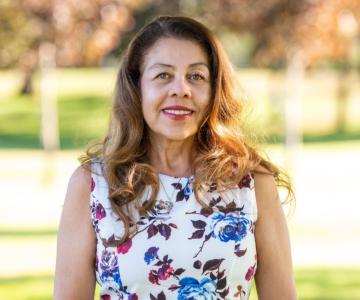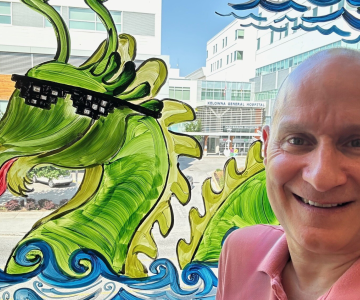Breadcrumb
Explore Stories
2 Minute Read
Community & Culture
Name: Trevor SpeedPronouns: he/him/hisJob Title: Corporate Director, Facilities Management & OperationsYears of Service: 15Worksite: Community Health & Services CentreCommunity: KelownaAncestral Territory: Syilx NationFavourite Quote / Advice to live by:
As cliche as it sounds, "everything happens for a reason," "be open to all opportunities within your leadership path" and "be comfortable being uncomfortable: look for opportunities outside of your comfort zone."
Trevor Speed, corporate director, Facilities Management & Operations, grew up in a “health-care household”: both his parents worked in the field. Trevor is passionate about keeping a focus on the patients and clients that Interior Health (IH) serves. He’s been very lucky in his career path and has had the opportunity to be a team member of several different departments within IH.
5 Minute Read
Community & Culture
Employee Experience is a small but mighty team at Interior Health (IH) that focuses on designing meaningful and welcoming employee experiences.
The team focuses on Indigenous Employee Experience, diversity, equity and inclusion (DEI), accessibility, recognition, employee storytelling and listening, and employee experience measurement. The goal? To create inclusive work environments for staff that are culturally and psychologically safe, where they feel comfortable bringing their whole, authentic selves to work.
We sat down with Isla Coombs, a business partner with Employee Experience, and her team. They shared how the team cultivates inclusive, trusting and respectful relationships with staff, communities and partners, including Indigenous partners, throughout the Interior Health region.
3 Minute Read
Health & Wellness
Some of our favourite summer activities like camping, hiking or relaxing at the beach involve us coming into contact with mosquitoes.
This can lead to mosquito bites and potentially the transmission of diseases. Mosquitoes bite animals to drink their blood and the animals can pass diseases to them. One mosquito-borne virus that has been found in B.C., although rare, is West Nile virus. West Nile virus can be found in many species of birds. Humans can be infected by West Nile virus if they get bitten by a mosquito who has also bitten a bird that has the virus.
There are numerous precautions you can take to prevent infection from West Nile virus - or just avoid itchy mosquito bites.
3 Minute Read
Community & Culture
Interior Health (IH) staff are beginning to transition to gloves featuring an Indigenous bear logo at work sites across the region. The logo not only represents cultural awareness but represents the vendor Medical, Surgical and Safety Supplies Ltd.’s profit-sharing commitment to support economic reconciliation for Indigenous communities, including the Osoyoos Indian Band.
5 Minute Read
Community & Culture
Welcome to the Meet Your Recruiter series, where we bring you closer to the dedicated professionals behind Interior Health's recruitment team. In this series, you'll have the opportunity to get to know the recruiters who play a vital role in attracting and selecting talented individuals to join our dynamic health-care team.
Discover their passions, expertise and invaluable insights as they share their experiences and shed light on the exciting opportunities that await you within Interior Health. As one of the largest health-care authorities in British Columbia, we are committed to providing exceptional care to the communities we serve. These are the people who help us fulfill this commitment.
4 Minute Read
Community & Culture
Name: Dr. Dwight FerrisPronouns: He/him/hisJob Title: Infectious disease physicianYears of Service: 23 yearsWorksite: Kelowna General HospitalCommunity: Kelowna Ancestral Territory: Syilx
When Dr. Dwight Ferris first came to B.C. in 2001, he became the only infectious disease physician for both the Interior Health (IH) and Northern Health authorities – covering approximately two-thirds of the province’s geographical area.
“One person alone cannot care for a million people,” Dwight says. “I was getting referrals from all over the province.”
Dwight has been happy to witness the steady increase of infectious disease health-care providers and services offered during his tenure.
“My proudest moment with IH has been seeing my teams grow,” Dwight says. “I'm really proud of the teams that I've been able to create and help thrive, and also the patients that we have helped. The greatest achievement for any physician is to see good health in their patients.”
5 Minute Read
Community & Culture, Health & Wellness
Smoky skies from wildfires can trigger anxiety or worry in children and youth, especially amidst evacuation alerts or orders. It can be hard to know how to communicate wildfire or evacuation information to children in a way that doesn’t cause them concern.
3 Minute Read
Health & Wellness
In 2020, Royal Inland Hospital in Kamloops began a three-year project to recover anesthetic gas from its operating rooms.
Anesthetic gases like desflurane are far more potent than carbon dioxide. Prior to the project, the waste anesthetic gases were vented outside the hospital, leaving a significant environmental footprint.
Today, all of Royal Inland’s operating rooms use anesthetic gas recovery technology. In early 2024, the technology was expanded to Vernon Jubilee Hospital and Kelowna General Hospital with plans for expansion to other IH sites.
From implementing digital solutions that replace paper, to reducing the use of single-use plastics, and supporting communities in adapting to climate change, we’re finding new and innovative ways to create a healthy, equitable and resilient health-care system.
4 Minute Read
Community & Culture
Name: Seija Emond (she/her/hers)Job Title: Mental Health and Substance Use (MHSU) team leadYears of Service: 20Worksite: Kelowna MHSUCommunity: KelownaAncestral Territory: Syilx
Seija is a single mom who values fun and caring and learning from a place of curiosity and humility.
Born in Germany and raised in 100 Mile House, Zaire (now the Democratic Republic of Congo) and Enderby, Seija grew up playing music and singing with her family. They even did professional puppetry together. Her family and she still get together for jam sessions from time to time. “We are not especially good at it but those are the best times ever!” she laughs
Inspired by her mom’s career as a licensed practical nurse (LPN), Seija became an LPN in 2003 and started her career at Kelowna General Hospital and Royal Inland Hospital.
-
Load More
Showing 54 of 677
STAY CONNECTED
Receive news and alert posts, and Stories@IH blog posts, right to your inbox!

